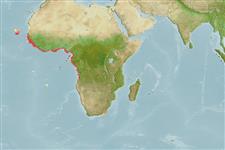>
Carangiformes (Jacks) >
Carangidae (Jacks and pompanos) > Caranginae
Etymology: Caranx: French, carangue, the name of a Caribbean fish; 1836 (Ref. 45335); fischeri: Named for Dr. Walter Fischer (1929-2023), for his vision and dedication in initiating the Species Identification and Data Programme of the Food and Agriculture Organization of the United Nations (Fischer, 1989), which in numerous ways, this program has been an invaluable resource for marine fisheries biologists and ichthyologists..
Environment: milieu / climate zone / depth range / distribution range
Ecologia
marinhas; Água doce; estuarina; intervalo de profundidade 6 - 25 m (Ref. 58464). Tropical
Eastern Atlantic, including the Mediterranean Sea and Ascension Island.
Tamanho / Peso / Idade
Maturity: Lm ? range ? - ? cm
Max length : 100.0 cm FL macho/indeterminado; (Ref. 58464); peso máx. publicado: 26.0 kg (Ref. 58464)
Espinhos dorsais (total): 9; Raios dorsais (total): 21-24; Espinhos anais 3; Raios anais : 17 - 19; Vértebras: 24. This species is a member of the Caranx hippos complex, and is distinguished by the following characters: segmented dorsal-fin rays 21-23 (exceptionally 24); segmented anal-fin rays 17-19, usually 18; posttemporal bones are hyperossified in specimens larger than 20 cm FL; cleithrum, first pterygiophore of dorsal and anal fins, and neural spines of vertebrae are relatively slender and never hyperossified; in specimens >20 cm FL, heights of longest dorsal-and anal-fin rays are both 0.7-1.3 in head length; in adults, anal-fin lobe white anteriorly and remainder of fin is gray to brown (Ref. 58464).
This species is reported to occur in moderate to large schools in coastal areas, estuaries and lagoons that are essential habitat for juveniles and young. Reports that it descends far up coastal rivers to spawn are unconfirmed and true freshwater occurrence is doubtful, but there are verified collections of juveniles from three separate coastal river drainages. Feeds mainly on fish, shrimp and other invertebrates. It has been a focus of commercial interest and may be utilized fresh, frozen, smoked, dried-salted and for oil and fishmeal, with edibility reported as poor to good, and taste improves when bleeding upon landing is done (Ref. 109259).
Ciclo de vida ou comportamento de acasalamento
Maturidade | Reprodução | Desova | Ovos | Fecundidade | Larvas
Smith-Vaniz, W.F. and K.E. Carpenter, 2007. Review of the crevalle jacks, Caranx hippos complex (Teleostei: Carangidae), with a description of a new species from West Africa. Fish. Bull. 105(2):207-233. (Ref. 58464)
Status na Lista Vermelha da UICN (Ref. 130435)
Ameaça para os humanos
Harmless
Uso pelos humanos
Pescarias:
Mais informação
Nomes comunsSinônimosMetabolismoPredadoresEcotoxicologiaReproduçãoMaturidadeDesovaAgregação de desovaFecundidadeOvosDesenvolvimento dos ovos
ReferênciasAquaculturaPerfil para aquaculturaEstirpesGenéticaElectrophoresesHereditariedadeDoençasProcessamentoNutrientsConversão de massa
ColaboradoresFotosStamps, Coins Misc.SonsCiguateraVelocidadeTipo de nataçãoÁrea branquialOtólitosCérebrosVisão
Ferramentas
Relatórios especiais
Baixar XML
Fontes da internet
Estimates based on models
Preferred temperature (Ref.
123201): 16.2 - 25.7, mean 19.7 °C (based on 72 cells).
Índice de diversidade filogenética (Ref.
82804): PD
50 = 0.5000 [Uniqueness, from 0.5 = low to 2.0 = high].
Bayesian length-weight: a=0.01738 (0.00796 - 0.03794), b=2.94 (2.77 - 3.11), in cm total length, based on LWR estimates for this Genus-body shape (Ref.
93245).
Nível Trófico (Ref.
69278): 4.2 ±0.7 se; based on size and trophs of closest relatives
Resiliência (Ref.
120179): Baixo, tempo mínimo de duplicação da população 4,5 - 14 anos (Preliminary K or Fecundity.).
Fishing Vulnerability (Ref.
59153): High to very high vulnerability (67 of 100).
